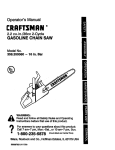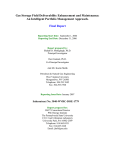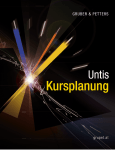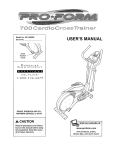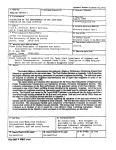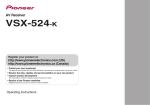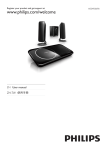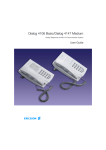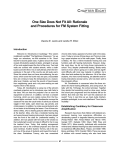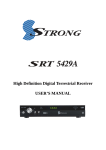Download Cochlear Implants - Digital Media Library
Transcript
_ -.. --
--. -
-
.
Cochlear Implants: a tips & reference guide for teachers working with students using CIs
Master's Project
I
I
i.
I.
.,
Submitted to the Facuhy
Of the Master of Science Program in Secondary Education
Of Students who are Deaf t>rHard of Hearing
.
National Technical Institute for the Deaf
ROCHESTER INSTITUTE OF TECHNOLOGY
By
Thomas J. Obi
In Partial F1dfi1hnent of the Requirements
For the Degree of Master of Science
Rochester,New York /I
June 12,2003
Approved: I\P~
(Project AdVISOr)
'~A.
/bu(J)a.
~
---
(M11~~IH-M~
Acknowledgements
This booklet is a product of collaboration with persons whose understanding of the subject far exceeded
my own. To this end, the author would like to thank
Josara Wallber and Don Sims for their valuable input,
time, and guidance. I want to thank Catherine Clark,
Coordinator of the NTID cocWear implant team, for
her willingness to share her vast repertoire of knowledge and resources. To all of the above mentioned,
without your review and feedback throughout the
creation process, this booklet would remain far from
being complete.
Cochlear Implants:
a tips & reference guide for teachers
working with students using CIs
A special thanks to Dr. Gerald Bateman, MSSE Program Director, and Nora Shannon, MSSE Coordinator of Student Teaching.. .two wonderful role-models
for teachers. Your persistence in making sure I didn't
"skip out early" and constant support since day one
has been invaluable. Thanks for helping me to arrive
at this new beginning with a Masters degree in my
hand. Thank you to Nora for being of help in the final
editing stage.
Also a special vote of thanks to Marty Nelson-Nasca,
Director of the Monroe BOCES #1 Program for Deaf
and Hard-of-Hearing students. Thanks for all your
effort to help me collect information from those that
will benefit most from this booklet; Teachers of the
Deaf themselves. Because of your help, their feedback guided me along the design process with a clear
focus on what was going to be most practical and
helpful for the teacher on the "front line". To those
teachers and audiologists who provided this feedback.. .countless thank-you's.
Cover pbotos courtesy of Coc:bIear Americas,
Advanced
Bionics, aDd Med-EJ
Table of Contents
The Purpose of this Booklet
Like a stampede, the cochlear implant (CI) has taken the worlds of deaf and hardof-hearing persons by storm. From its inception in the mid 1980's, some have
embraced the technology as a miracle cure, while others have thought of it as
cultural genocide. Yet, today, many would argue that the implant has come and is
here to stay.
Page
U". '''00' . . . . 6
Wbat;is a Cochlear~plant
"
~A
There are many teachers with students using implants who feel inadequately prepared to deal with this technology. You might be one of them. If you are, this
booklet is for you.. .keep reading! This book will provide you with skills and expertise related to working with your student. My goal in providing you this resource is threefold:
. ... . 8
Why I Need to Know About Iinplants
Approved Cochlear Implants.,. . . . . .10
The ImpiantatiopPJ;ocess
. . . . . . . .';'~... . 14
Workin,gwitla theStg,dentAfterU!)ok-Up
Using AssistiveLis~g
'16
Devices.. . . . . . . 18, ~~"
'i"~~
Teacher ResponsibiJifies
Encouragingind~JH;?dence
TheClassroom,EnVD"Onment.
.'. . .. .. . . 20
24
Auditory
''-'I'' . & ~peech,~~R~)habilita~..
"D
" ~VaOpmg
,
~
P,~"",'3!:~
'cu.~~~IUPs..
;
i
',' 2%!,/
'
.~..
' '~'
'
'
"~
~9 i
~;
""'"
.
Q~ci'1)ps...
~:~
:;;,
~
e,.. .". ~:..,::
Ftequently
Asked: Ques,tions
:~
,~~~'~~,..; ..30,;;
:.
.J;!
31;1
,
GIossary..,,
R,£e~.~,.,~
.~.'.f.""
e;.".. .'.,j~.i!f.."..:,~2f"
..,8'.t.:::1'
.~~i. ~,'.-,.'".,
".,'i1~:r~.;.,...,.,:~'
't':'
~
'R~~rces.,.
4
.'. . .
'~'.. . >
. e,_
TroubleshootingGulCi'e....
n.
: <
(,
i?~"
t~;!.
Photo councsy of Moo-E)
1.) To enable you to become a teacher that
can help your student become a successful
(Le. auditory and speech skill development)
and independent implant user;
2.) To prepare you to be an effective consultant
to and partner with parents, teachers,
audiologists, speech-language therapists (SLPs),
and other colleagues in your immediate
school environment; and
3.) To guide you to other resources that will
assist you in finding answers to questions
not included in this booklet.
As a teacher myself, I believe it is our professional responsibility to meet the
needs of our students to the best of our abilities. If you have a student using an
implant, this booklet is a great start (and a great resource guide to keep returning
to). Recognizing the time constraints of a teacher, I have attempted to pull together a wide breadth of information from multiple sources in an easy-to-read,
easy-to-find format. After reading this booklet, I hope you agree.
. 3.6'
;,39'
Tom Ohl
The Author
5
What is a Cochlear Implant
rrijfssectfonprovIdes
.you \Vlthim expla~
A simple definition
~ation of what an iwplantis by giving
!you a,simpl~ ~finiaon 9ffue device.arid
its use: ltaIso de'~c:fi~tbe:partsof'aIl
i,iinplanfand
J10wit,.wod<s.
, -,
~.~ -,
~'-
.
receiver/stimulator
.
~
' '.
#
.
,J'/
-
---;:.
..
...
.
:...,"'~\.
~j;J-,
.
;
..;
(
.
'.'
",
,..,'
..'
'.
..,
.
..
y
/
/
.r
\~
-.
I
A cochlear implant, or CI, is a batterypowered electronic device. It is designed
to improve a child's ability to detect
sound and therefore, the potential for
greater speech understanding when benefit from hearing aids alone is negligible.
One part is surgically implanted into the
~.
cochlea and surface of the skull while
':\
''1\
another is worn externally like a hearing
,.!, aid.
I
antenna
I
Internal components
I
Unlike a hearing aid that amplifies sounds
going to the ear, a CI bypasses the damaged ear hair cells by sending a programmed electrical signal to the remaining healthy nerves in the cochlea. This
stimulates the auditory nerve directly,
which can then relay the information to
the part of the brain that is responsible for
hearing.
Parts of a typical implant
Although CI systems can and do differ
(manufacturers offer various numbers of
channels, electrodes, and speech coding
strategies), all implants share the same
basic components.
Internal Components
1. a magnet, antenna, and
receiver/stimulator
2. an electrode array
External components
3. a microphone
4. a speech processor
5. a transmitting cable
6. a transmitter coil with magnet
The external portion may be worn entirely on the head (behind-the-ear/ BTE)
or in combination with a body-worn component.
6
C\r;~;;
'.~~i",
. '-1\
@ \. !
.. '>',U'K.P
<;,' ,,;;..:,
.\;:~;~~~n:
:! V \.,\'..,
i,It':""~")~
I.'
I
.'
!"..v",.
c~~~ri;
"_'Clio"."!:";!;" -","
..~.~y.'
_'~;l;;;":-;;:'...::'.r I'
~";'"'J~~~~"\'::.'
","
~i';"\r"".~-!:,,,:
1"4i~~"'"
f:\"";:~':
...~'{~.
. ';,>'
.
PboIOS COUJleSyof Cochlear
Americas
Body-worn
Processor
1:1. !I
I
i'
E~:::~~~~:;~~;?Y:,~;;~",
,
""
..'
"
.;:il;;~f
">J,
. \.
'
i.',..
. 'j;'~..#-."I',,,~
~,:'
.
'I
~~:
.
..
.:~~~~~~",'~
.
. ttt,8,J~~
~..
,.
1 ','~:
"L{~::.;~;
'\+',' ~
~,'~\
>\ ' ~;~'.
, t. ~@
Ii:";"
. '~h
'J;1;fJ,1t..c>.,
l!C'C
:~.a"
"
\
-
How it works
~~i. ..
'
,~i.
r I: =",:p;
'(?.
~I!I' t. . '''":~~'~;::'.~' .
" .( "-+.;;.~,;,..
i
~ r' j''',''~''~~;,:~
~.
~"'(~
t
.
:,'
.
it,.
if! ~;~'t'\.
~
I¥~\
.
~di
\."' "'.ft':~~1{:"i\
;"';;'
"
.
"'. 'ii,
"
\~:.~,
':~
.
\,
.2'~1"
t ':'. . ';~'.>
:~ .
'
'" . \,',~'
~'~',
~'!v,",,~
.'.
..%,..~
~"'
~r~~r'£i:il'~:;
.
,.,.tl"'.,
.
~
""'~~--~;:.~:;~~~
'~,........
' "T ..." .~"'.."
h, )'.'""~"
~ ~w,..~~~.~':;~~.7~.."'..:;~~-,0.::-.
-~
,..-....
-.Ioi:.. . ,./~'!,:"~"~;/
J
, '..:'~:y~
,."
\
""
~..
..
P ,~ A.',
' I ,Ji(;;f.~
..
'
I~ ~
..
.
.
...
..
.,..
.
.':
.!J.
.
<-;'Y;;~:~'. l...d"'"i1'~J~
"
Photos coUJleSy of Cochlear Americas
J
",,'f.',\-,
"""~J',~.J:>,J~"
,"
'
'-"
"
'-
,i,,I.
,.'
".
"',
..-.-
~.
1. Sound is picked up by a directional microphone.
2. Sound is sent from the microphone to the speech processor.
3. The processor, programmed with a speech coding strategy*, analyzes, selects and
digitizes useful parts of the sound (i.e. for speech and music) into a coded electrical signal.
4. Coded electrical signal is sent through the transmitting cable to the transmitting coil.
5. Transmitter sends code across the skin to the internal receiver/stimulator.
6. Receiver/stimulator converts code into electrical pulses. These pulses are targeted to
stimulate specific electrodes in a speCific manner.
7. Electrical pulses are sent to the electrode array to stimulate the remaining healthy
nerve fibers.
8. The electrical signals are sent via the auditory nerve to the brain. There, the electrical
signals will be interpreted as sounds, producing a hearing sensation (within
microseconds of the microphone picking up the sound).
*A "speech coding strategy" refers to the technique the speech processor uses to translate the pitch, loudness and timing of sound into the signals the implant sends to the
cochlea.
7
Why I Need to Know About Implants
'¥?u:havea stUdeiitu~1l}S';1,Cfln YQur,.
classrQom. ]~ecaus~you havt( tb.e~$tuciel!t's'besfih~rest at~art, you waritto
.know. However,;whiltifyou
don't have a
iCl"srudent? This sectionoffers,additiomil
rationale ''to kDow" for aU teachers by
.addressingjncrea$~ng candidacy require- i
ment$ and num~rs, tb.~cochlear implant,
90ntre>versy,anifthe.te3Ab~' srol~in
ici~ntii'Y'in$
po!e,ntialc~idates.
..
Expanding FDA criteria
1990
Expanding
Today
criteria
Minimum
AGE
2 yrs.
ONSET of
hearing loss
prepre- &
linguistic postlinguistic
DEGREE of
permanent
sensorineural
hearing loss
profound 2 yrs.
IOOdB) severeprofound
7OdB)
<2 yrs.
profound
9OdB)
0%
Lack of audibest
tory progress
aided
5 30% on
condition age appropriate tests
CHILD
speech scores
12 months
Numbers rising
The number of implant recipients has
steadily increased over the past four years.
Today, there are over 60,000 recipients.
Manufacturers expect this growth to increase 20-25% yearly.
This growth can be attributed primarily to
expanding FDA criteria for potential candidates due to advances in technology.
Since 1990 when children (of age two)
were allowed to be implanted for the first
time, subsequent changes have lowered
the age of implantation to 18 and 12
months in 1998 and 2000, respectively.
Today's FDA criteria also includes children with severe to profound hearing loss
(previously only those with profound loss
were allowed). Though children represent
a small percentage of the severe-profound
population, child hearing-impairment is
thought to be under-reported.
The growth may also be due to changes in
disability law. Severe-profoundly deaf
children who might have previously been
placed in a residential deaf school are now
being mainstreamed under the Least Restrictive Environment provision of the
Individuals with Disabilities Education
Act (IDEA). As a result, more deaf children are finding themselves in Hearing
school environments where the benefit of
better speech and auditory skill development is much more advantageous.
Which of my students
might be a CI candidate?*
(ShouJdanswer"yes"toall)
Do they have severe-profound sensorineural hearing loss (nerve deafness) in both ears?
Are they failing to progress in the development of auditory skills?
Are they receiving little or no benefit from traditional amplification (hearing aids, FM)?
Are they healthy (no contraindications)?
Is the student and family highly motivated and do they have appropriate expectations?
Is appropriate auraVorai support stimulation available in the school?
8
*Candidacy needs to be determined collaboratively (teacher, audiologist, SLP, etc.)
The historical controversy
The controversy today
Throughout the history of deaf education, there has been a strong pull from
two viewpoints-the
medical view and
the cultural view. The former views
deafness as being abnormal and needing
to be fixed, with the goal of integrating
deaf children into a Hearing society.
The latter views deafness as simply
being different and needing to be explored, with the goal of helping deaf
children find a pride and identity within
a unique Deaf culture.
Through time, the controversy has
evolved. Most dramatically, the NAD
stated in its 2000 position paper that it
"recognizes the rights of parents to make
informed choices for their deaf and hardof-hearing children, respects their choice
to use cochlear implants..., and strongly
supports the development of the whole
child and of language and literacy." This
change reflected a willingness of the Deaf
community to give up some "ownership"
of deaf children and begin investigating
the implant within the context of Deaf
culture.
Since the FDA approved the Nucleus
22-channel cochlear implant for surgical implantation in children aged 2
through 17 on June 27, 1990, the controversy has continued.
In a 1993 position paper, the National
Association of the Deaf (NAD) deplored the decision as being unsound on
scientific, procedural, and ethical
grounds. While making no reference to
parents' rights to choose, they claimed
implants to be highly experimental with
little evidence of benefit and little concern over the future quality of life of the
deaf child physically, emotionally, and
socially. Understandably, the Deaf community saw the implant as a threat to
the preservation of their culture.
Those outside Deaf culture with a medical perspective perceived the implant as
a miracle device able to restore the
hearing of deaf children. Their hopes
were placed on the device's potential to
help a deaf child develop spoken language. Many of them failed to agree
with the NAD's position, arguing it was
internally contradictory to maintain that
cochlear implants do not work and yet
work so well they will eliminate deafness.
However, the 2000 paper also stated
"many within the medical profession continue to view deafness essentially as a
disability and abnormality and believe that
deaf and hard-of-hearing individuals need
to be fixed by cochlear implants. This
pathological view must be challenged and
corrected by greater exposure to and interaction with well-adjusted successful deaf
and hard-of-hearing individuals." Thus, it
is apparent that the Deaf community has
retained its sense of pride and identity.
Many people have strong opinions about
CIs. You, too, may have an opinion. Regardless of your stance, though, knowledge that such a controversy exists is invaluable. Allow it to spur you on to .investigate and search out the facts. Use this
booklet to prepare yourself to be a useful
resource to parents and other teachers
when they approach you as the "expert".
Be ready.
9
~fS(~ecP~~teC~~~fietp~~yOu.;~u.'
:recognize'tb~'.'q[d~vi.~;'yq9t;sfud~nt~y
\vear~andrprov,tdey<?\,~th a'des~r:iption
jofeach that.is,usefliltoyou as a teacher._
11Bea~. tbatold~J,'s~dentsII!~Y,be
~~e~~t~!der:n:~~~~~~etaiIed
here."
...,
~~
~~~
'»'?""'~~!JI!n',,"7~~""2":~;X:~,:'
'''''''''''>1.__ ___ _
.
'..,
t
.;.,.'.
'.
,',
Photos counesy
,S~tBQ~Y
"
.
i'acces~
"
toc'Qntrpls;
r,}!
.4fi
~,~tiI..
·I
~
of Cochlear Americas
program
selection
control
I
Base Controls
I
'T'for
telecoil
..
J:)
~
.
~~ .,
mode setting
switch
.
!~
I
I
10
I
i \
wqBN P~OCESSOR
~. .$u~f1$el~ta9Jm~~ams
. . ".
'
,. .'"'
" ' ''' ". .~ . ...~
~¥'fI; "'t' . '"
.... . .
. 0 pl'e¥en t. .
;pqtgue'J,ea'I.I£"'~,~~oclf"
.
! ,.
.. .
. .
TopC4!n~ols
volume or
sensitivity
control
..
Nucleus Devices
~~~'i'f./
~)~~';L~ar,
.
I
Control Buttons
Parts labeled I
I
11
,.
,
CnHn~esAuria,BTE
PROCESSOR
:'(N~,!i'~c.-~]~une<~~l
" ,e,£eatw:~..,.~es
Clarion Devices
,
:u,nd,""
."
Photos counosy of Advanced Bionics
cn BidnicEar BOD"tWORN PROCESSORS
8
3 userselectat:>le
programsforS-Si::'iies
18
I
eSitln~e~
'~oJ~n4~ig~a!f
I
~...~
l'
G
~
:'2,*~", "_"
'
.
.
~"
~
"'.:"';~.........
,~.:
~
.
.
.~Pt3~t
p~rcif, it:
3~~_sel~(,Wib!e,'P1Q~amSfor :PIa.ti~mnSeri~~
s-Series (older model)
r'
I
Parts labeled
I
:.
J
I
I
Platinum
Series (newer model)
I
COMBI 40+ Devices
I
Controls
I
--~Id"'mIiQ~,RIi'
;":',B
'It\;vawARN
.
. ."'. ."" .., ,".
nKL~~._
RR~GEs~tiVI
J
Photos counosy of Med-E)
.'
;;..'.',,1
,#
...8i
TEMP<1+BTE PROCESSOR
'
1"jI
..
",'..
~-
'''I'
.-'-
..,.
,.
"-.;L-.
~tJI1ique~featui:e.
us&r.s~lecta1?le
progr~Ts
"
. .~1ilti"p1ewearing
.
options
12
13
The Implantation Process
..Asthe student's teacheii'you are notexpec!OOtodotheac~.9nplantittg;Qfthe.
deVic~;Hl!lweve("youfria.t:J>eintefacti~g
wit'h,thestudent as he'o($ne gOesthiougl
ihis::process.Itis:in'1po~ftbat Y01I';be'
:ab}eto understancfwhatiS.QCcim:ingin .
their life outside o(.school'(and why they
'iaremissing days ofschool)..This section
'1gives a brief outline of what your student
m~Ybe~eri~c.ingCU'jnayhaveexperi".
-enced
~. ,in the
'~ paSt.
\
," :-
l
The surgery
Cochlear implant surgery is performed
under general anesthesia, in an outpatient
setting, and lasts for about 3-4 hours.
Most children go home the same day or
spend no more than one night in the hospital.
During the surgery, the electrode array is
threaded into the inner ear and the receiver coil is placed in the drilled out bone
crevasse behind the ear. A pressure bandage is placed around the incision. Generally, the incision needs 3-5 weeks to heal
before the child can have the external
parts "fitted". However, within that time,
most will feel well enough to resume normal activities and return to school.
When your student returns to your classroom, they will most likely no longer be
wearing a pressure bandage. However, the
area of the child's head where the external
implant will later be placed will be
shaved. Some teachers may choose to
prepare the other students for the child's
return. Others may allow the implant child
to explain for him or herself when they
return. Regardless of your approach, it is
important you do not allow the implant
student to be made fun of or feel rejected
by his or her peers.
Hook-up day
This is the point at which the student is
"fitted" with the external implant parts
(the transmitter and processor). It usually
takes place 4-6 weeks after the surgery at
the implant center. Before this point, the
child is unable to hear with the implant.
Commonly, the event is referred to as the
child's "hook-up day" or "initial stimulation session".
On hook-up day, the MAPing process
occurs in which the child's initial
"listening" program (or more if the processor allows for multiple programs) is
programmed into the child's speech processor. This program is designed to provide
your student optimal access to the speech
spectrum.
Be aware that many children continue
use of conventional amplification (i.e.
hearing aid) in the un-implanted ear.
What is a MAP?
A MAP is the "listening program" stored
in the memory of the student's speech
processor. It is created from a computer
and special program that measures the
child's responses to quiet and louder
sounds. More specifically, it determines
the "threshold" (T-Ievel) and the
"comfort level" (C-Ievel) for each electrode that has been implanted in the
child's cochlea.
Follow-up after hook-up
After the initial "hook-up day", your student will go back for periodic visits to
have their speech processor fine-tuned.
The repeated visits are necessary because
it takes time for the hearing nerve to adapt
to the new electrical signals from the electrodes and for the brain to learn how to
interpret these signals. As time goes on
and the MAP becomes more finely tuned,
the number of adjustments needed will
decrease.
Be aware that you may be asked by the
audiologist or parent to monitor which
program/MAP the child is able to hear
best with.
14
15
Working with the Student After Hookup
.IJDnle<;\iately,after
aStu@ntrecei¥~san.
Monitoring
itnp1ant,there aretwo:tD.ainconcerns.
'First,is theimplant de"ice and MAP
working? Second, how is the childun,
'derstanding the new sounds they hear?
This section gives teachers helpful .
information to be used when addressmg
Most importantly, a daily routine to ensure the device is working properly should
be established. This daily functional check
should involve having the child listen and
respond to his or her name and detecting
or identifying a set of speech sounds using
.2~9ueSti0Jl.~.:
~~
" ..
the Ling six sound speech test.
Ling Six-Sound Speech Test
.
·
·
Assume the student will respond to sound
in a structured environment. If they do
not, or their listening ability decreases
suddenly, the device should be checked
immediately. Document any changes that
persist or worsen over a period of more
than a week. Your notes will be valuable
information for the implant center, school
audiologist, SLP, and parents should they
contact you.
1. Sit at level of the student 3 ft. away.
2. Cover your mouth with your hand.
3. Say in a normal tone of voice...
ah (as in father) 00 (as in moon)
ee (as in key)
sh (as in shoe)
s (as in sock)
m (as in mommy)
Be sure not to get into a rhythm and
each day, present in random order.
4. Have student respond in a manner
that matches your goal.
If detection, raise hand;
If recognition, imitate sound.
Remember:
First focus on student detecting the
sounds, then recognizing them.
High frequency sounds Is, sh/ are
new to the student and initially may
be more difficult to recognize.
Regardless of whether the student
·
During the first three to six months, it is
natural for the child using an implant to
need changes in their MAP. Be sure your
student knows it is a natural and positive
result of them becoming more accustomed
to sound.
Because many students will be unfamiliar
with the device or unable to provide feedback regarding sound quality, it will be
your responsibility to monitor the student
to identify when MAP changes might be
necessary.
detects or recognizes the sound correctly, give encouragement. All students need to know they are doing a
good job listening.
Perform the test at both 3 and 6 feet.
Abridged
.
.
.
.
.
the CI & MAP
from A Teacber's
Making sense of new sound
From school belIs and screeching chairs to
speech at conversational levels, every
sound your student hears through the implant system is new. You must realize that
the sound they are hearing is different
from what they heard with their hearing
aids. It is your job to help them make
sense of this "new" sound. Here's how
you can help. . .
1. Don't expect initial recognition
It is possible the child will need to hear a
sound or word many times before recognizing it. Don't be afraid to repeat it for
them. Be prepared to use your teachergifted patience!
2. Draw their attention to sound
Hearing babies naturally learn to associate
sounds with objects in the environment
quickly. Your student will learn to do the
same as they begin to hear more and more
sound. Encourage this learning process by
prompting them to attend to sounds in
your classroom environment such as the
belI ringing or someone knocking at the
door. This sound-object association will
become a vital foundation.
3. Give a chance to listen
Even when your student does not respond,
assume they can hear and just need time
to process. If a sign, visual, or gestural
clue is necessary for understanding, do so
of withdrawnbehavior.
.
Diminished response to environmental
sounds.
Change in frequency of vocalization,
voice quality andlor vocal intensity.
Slow reduction in distance listening.
Student consistently alters sensitivity
setting by more than 2 numeric levels.
(higher or lower)
.
.
.
.
.
5. Allow early success
For many deaf children, hearing has been
a frustrating chalIenge frequently leading
to failure. As a result, they tend not to
trust their hearing. You can help your student succeed by limiting the amount and
complexity of the information you provide
them. Use familiar acousticallycontrasting items, and move from simple
to more complex structures as when trying
to increase their acoustic memory.
6. Provide context
Providing meaning is essential when integrating sounds. Making your classroom
context-rich could involve the establishment of daily routines or repeatedly focusing on key words during your instruction.
Just as with any student, goals are vital in
providing a target at which to aim. Consider the child, the family's desires, and
current research. Use this information to
set auditory goals that will be chalIenging
for the child, yet not overwhelming. As
you move toward the target, periodically
check back to make sure established skills
are maintained.
Increased requests for repetition or use
"What?"or "Huh?"
"Slushy" production of formerly
mastered speech sounds.
Omission or confusion of consonants
that were formerly present or
discriminable.
Neutralized vowel production.
Presence of physical symptoms such
as an eye or facial twitch.
4. Create a listening environment
Make a concerted effort to limit background noise (Le. use Assistive Listening
Devices, close doors and windows) and be
willing to adjust your teaching style.
When lecturing, you may need to slow
down, repeat often, and be mindful of how
you position and emphasize words.
7. Challenging & reasonable goals
Guide.. .(2002). p.IS
Observational clues that a MAP change may be necessary:
Emergence of persistent disruptive or
but always end by repeating your question
or comment in auditory form. This is
calIed making an "auditory sandwich" (auditory first, then visual aid, end
with auditory reinforcement).
Abridged
from A Teacber's
Guide.,,(2002),
p.14
17
Photo counesy of Me<J.EJ
I
Using Assistive Listening Devices (ALDs)
i!Fiu.1tsectffii-i~~.w'1IYALI;5s are,
iben~da1and the ways;in which;they c"
ALDs and implants
The most common ALD/implant pairings used in schools are:
,".lsO}PI:Q.¥idesirifonIl;itl9ri.~nselecqng;aft
an induction neck loop used with a
". .. "'opriate
AW,
.otteJ:S''CQJ;lSid~ration$
.
'
"
'.
.
'''''''
l''FM;
c'Wl
.th
.:
.
""""',
wk ~ s. ..ia'i .'" ~'O
.
. ..
..,.'
..\L'
um~
~...~ .
...,.,'@.'-"'I"
able telecoil on a~a:
iU1d~coin'age~youito'c<)Dsider
the
built-in
or attach- r~:*~('
BTE implant;'
...0:'"
.jriteiface.With
a,cqCid~artlJlplimt.:ft '
"
.
.
.
.
.
.
'
.
.
.
.
Choosing an ALD
In deciding which ALD is appropriate
for your student, there are several things
you need to keep in mind:
.
Sound-field PMs (e.g. desktop
"
.
.
~chooL~'.yfrpmnentM;WhQle.
. ",---""",_~"""":P"-"'~:-''''''''hdw;.,p.~""".,.;w,~.,~
,.~
"..,
Why use ALDs
Some teachers may assume that ALDs are
unnecessary given the fact that the child
has an implant. However, the speech processor will still choose to send the loudest
signal to the ear. Therefore, even with the
best technology, children who are hard-ofhearing or deaf will hear best when the
sound source is within 3 feet and there is
no competing noise.
.
(Nucleus 3G BTEs
have built-in te/ecoils);
.
a sound-field FM speaker unit,
usually placed on the child's desk,
used with a body-worn or BTE implant; and
.
~::.-'~
.
.
...;...--
.~
.
When to wear an ALD
For newly implanted students, hold off on
fitting an ALD. Do so even if they had
been using an ALD system prior to getting the implant. They first need experience hearing sound with their implant
alone. This is extremely important for
very young children who often show
minimal responses during the early implant stages. The PM can be easily coupled to the CI after you and the audiologist are confident in the responses of the
student wearing only his implant.
18
a personal direct-connect FM receiver that inputs directly into the
speech processor of a body-worn or
BTE implant. (There are two FM
systems capable of directly attaching to an implant: the A VR Sonovation LogiCom Ci and the Phonak
MicroLink).
Troubleshooting ALD systems:
Checkfor:
..
Weak battery
Defective cords, buttons or antennas
.
Microphone plugged in incorrectly
.
Channel interference
Personal PMs are recommended for
students in middle and high school
who change classrooms or participate in after-school activities since
they offer the greatest portability.
.
.
ing no extra body-worn equipment.
Telecoillinduction loop systems
require an extra body-worn receiver.
Personal PMs can be cumbersome
Personal PMs provide optimal signal-to-noise ratio.
.
.
Sound-field PMs are easiest, requir-
because both the body-worn PM
receiver and body-worn speech
processor may be required. Though
capable of attaching to a BTE implant, the child would still need to
wear a body-worn PM receiver and
patch cord. (In Fall 2003, BTE CIs
will be compatible with the wireless
MicroLink FM receiver.)
..
The purpose of an ALD is to increase the
signal-to-noise ratio by reducing distance,
sound distortion and room reverberation.
The child benefits by being less distracted
and being better able to concentrate on the
teacher.
speakers) are recommended for very
young children unable to report a
malfunction or students with limited
implant experience because teachers
can easily monitor the signal.
Considerations
when coupling
Modifications to the PM may be necessary so the student can monitor
their vocal productions. (particularly
for MSPs or Spectra processors wi
serial #s bel~w 34000)
Certain PM channels are preferred for
.
Personal PMs can be used in group
discussions. However, because the
coupling* renders the implant's earlevel microphone inactive, the
teachers transmitter mic would need
to be passed around or a PM conference mic placed on the table.
* "Coupling" refers to the use of a cochlear implant with any other listening device that has the
capability of anaching directly. Such devices include FMs, CD players, personal radios, tape
recorders, televisions, and computers. The patch
cord necessary to connect the CI to a particular
device will depend upon the device and the brand
of implant. Because of this, it is important that you
communicate with the educational audiolagist to
obtain the proper cords through the manufacturer.
.
use with students who use CIs as they
are less susceptible to electromagnetic interference from fluorescent
lighting, computers, etc.
Interference is possible between the
speech processor and PM receiver.
Maximize the distance between the
two units given the connecting cord
and size of the stiIdent. If your student reports their PM has static or is
buzzing: have child move to a different place; reposition PM receiver;
move PM receiver away from speech
processor; change PM channel; replace connecting cord from PM receiver to CI speech processor; or try
using a shorter transmitting cable
from the processor to the microphone.
Being tied into the teacher's dialogue
may be appropriate for teacherdirected activities, but less appropriate for independent or group activities. In small groups, the child may
miss opportunities for incidental language learning if the teacher's voice
is the primary signal and the teacher
is talking to another group.
Abridged from A Teacher's Guide...(2002), p,I8.19
ALDs in the school
Be mindful that your student may be one
of many children using an ALD in your
school. Address this issue with the entire
school staff so that each classroom is on a
different frequency and arrangements can
be made for students who share activity
areas (e.g. gym, computer lab). Encourage
the establishment of a procedure for sending in broken equipment if one is not already in place at the beginning of the year.
19
Static electricity
Because an implant is an electronic device, proper precautions should be taken against
static electricity. Static electricity poses a danger to the speech processor, with the potential of destroying the processor's MAP(s). The following pictures illustrate some
DO's and DON'Ts that you and your student should be mindful of.
Don't pick up your implant equipment
without first discharging possible static
electricity build~up by touching the sur~
face that the device is resting on. In this
picture, the student should have touched
the metal desk first.
1. What are the parts of my implant?
2. How does my implant work?
3. What can I do and not do with my
implant?
4. How should I take care of my implant?
5. What could go wrong with my implant?
And what are the warning signs I
should be looking for?
6. What should I do (& who should I contact) if my implant is not working?
And is it something I can fix myself?
~ -..
\.
.
''C-
~
rir
~
~~?li
~
f.
'<
,
"t
'
I
'
~
r
.....
~
"
,,~'\
'~
,
,
'
,
,,
""~.:~?
PholO counesy
1
) ~"
of Oticon
~
f
What information you share and when
you share it will depend on the age, ability, progress and personality of your student. Be aware that some of this information may have already been given to them
by the implant center or their parents.
However, your review of the information
with them may still be helpful. You may
also want to communicate with his or her
parents to find out if there is any additional information they think is beneficial
for their child to know regarding the device.
Do remove your
speech processor
and headset whenever you are around
or before using play
equipment likely to
build up high levels
of static electricity
(plastic slides, tubes
and b~1 pits, trampolines). If you're not
sure, a tip-off might
be noti~ing, your student's fine hair
standing on end!
Do wear your implant cables next to
your skin under all clothing so that
static electricity will mostJikely go
through your body to th,e ground. If
you wear them outside, they may
brush up against or be drawn to objects with high levels of static electricity, such as a TV or computer.
larly; youshou1~tal- "
ways touch a,person
or object before your,
implant touches
them.
Don't touch a computer screen'while
wearing yourimplant..Jtls possible
to reduce st;itic electricity around
computers by plaCing an aJ}ti~static
shield over the computer monitor
screen and anti-static mats under the
chair, keyboard, and mouse.
Pbolos from Teacbet's Ouide...(l999)
Do's and Don'lS abridged from A Teacher's
20
Don't let aityone
touch your implant
without first touchin
your shoulder.or arm;'
They may have built
up static elecm~:ity
simply fromtouchin
a metal doorknob Or
walking acrossacai:
peted floor. Simi-
Ouidc...(2002).
p.7Z:'7S
21
Photo counesy of Med-EI
Moisture
Moisture, including perspiration, is damaging to an implant. Therefore, precautions need to be taken. They include:
Take off the implant before swimming or showeringlbathing.
Remove or cover the implant with a
hat or hood during inclement
weather.
If processor is worn on the front of
the body, be careful not to splash water on the implant when using a
drinking fountain or washing your
hands/face.
Use Dri-Aid to store the device.
.
.
.
.
Care of the implant
Using the system
r~
.
ing it. However, make sure you have used the batteries for more than 2-3 hours.
,"
.
Turn the processor off prior to changing the batteries, replacing cords, or plugging an
ALD into the externaljack.
.
Keep extra'cords and batteries in a predetermined secure place.
H the implant does get wet, take
the following steps:
.
1. Remove the batteries.
2. If dropped in dirty water, rinse briefly
with running drinking water.
3. Shake off as much water as possible,
4. Place processor in dry pack and notify
the parent.
Attach an ear mold (the kind used with BTE hearing aids) or a mic lock to the microphone to help it stay in place. This is particularly important for children who are
naturally more active.
.
Make an identification tag for the processor.
.
If the outer magnet falls off often, contact the parent or audiologist.
If the processor is not working the next
day, contact the school audiologist or implant center.
Abridged
from A Teacher's
Guide...(2002),
p.22
J
Cleaning the system
.
Physical activity
Even with the risk of moisture, the child
should not have to stop all physical activity such as running. Most children actually wear their implants for PE class.
However, go to the parents for input regarding its use in PE class as some children may be more susceptible to head
injuries and cochlear damage.
While no extraordinary precautions need
to be taken, protective headgear should
be used when it is available (for activities
such as biking, rollerblading and football). Children who play soccer should
be cautioned against "heading" the ball.
Photo counesy
of Otico.
Do not get sand or dirt into any part of the implant. If ~is happens, shake out as
much dirt or sand as possible.
.
.
22
It is not necessary to completely discharge the rechargeable battery prior to recharg-
For regular external cleaning, wipe gently with a cloth dampened with mild deter. gent. But before using, make sure the device is completely dry. Regul~ cleaning will
prevent dirt build-up.
Clean the device pouch using cold water and mild detergent.
Storing the System
.
For long-term storage, remove the batteries. Do not store the batteries in the refrigerator. Putting a cold battery in a warm processor could cause pro6lems with moisture condensation.
.
For long term storage, keep the microphone and processor (without the batteries) in a
DRI-AID kit to reduce problems caused by moisture. A modified DRI-AIDkit can
be made by putting desiccant inside an air tight plastic container or even a zip-lock
bag.
.
When not being used for a brief period of time, place theimplant in the storage case
or DRI-AID kit (particularly in humid climates) labeled with the child's name.
Abridged
from A Teacher's
Guide...(2002),
p.22 and Parents'
Guide (2002), p.2S,26
23
The Classroom Environment
Auditory & Speech (Re)habilitation
~
..,
Improving acoustics
The challenge
What makes a classroom so challenging
for a child using a cochlear implant?
Simply put.. .acoustics. Your student is no
different from a child who uses hearing
aids in that their sensory aids are often not
enough to overcome the adverse and competing noise found in the learning environment. Thus, you must be willing to
modify your room to improve the implant
child's ability to hear, ultimately increasing his ability to communicate and interact with his or her peers and teacher.
Providing
visual support
't
'Because students do
.
.
~:
I
.
.
.
.
Have the chlld SIt I!:
where they can see
your face and others' faces if in
discussion.
.
.
Carpet floors and hang curtains on
windows. If carpeting is not available, table and chair feet can be padded using old tennis balls.
Arrange seating so that student is
away from the doorway, fans, overhead projectors, and heater/ac.
Because implant microphones are
directional, the student should always
sit facing the sound source with the
signal directed toward the implanted
side of the head.
Put acoustic tiles on hard, reflective
walls. If you can't convince your
school to do this, you can hang cloth,
paper, or possibly a corkboard instead.
If desktops lift open, you can use cork
or felt to reduce noise from them
opening and closing.
Consult the school audiologist or SLP to
evaluate the physical arrangement with you.
Modifying instruction
Position yourself
so that light
sources are not
behind you.
Use overheads and
handouts as opposed to the blackor white-board.
For those who use
an interpreter,
place interpreter
near teacher and in
a visible location.
Photo courtesy
24
.
.
gain somebenefitfrom .
speechreading:.
..
of O,icon
'
',~,,:,1"
"'., .'
,',;'...
Several modifications can be made to reduce noise and heighten your student's
ability to hear in the classroom:
Close the classroom door.
The 8 Gui€lingflfinciples
1. Thedevelopme~t.
ofs~h ,eerccp..
2.
What you need to know
To help your student obtain optimal
benefit for auditory and speech development from his or her device, there is
some information you will need to know
before planning and implementing a
(re)habilitation program:
·
Date of hearing loss onset (pre- or
post- lingually deafened).
·
·
Date of initial amplification (how
long have they been a CI user?).
Student's level of skill with the implant at the current point in time.
·
·
3.
The child's post-implant audiogram
(see page 26 for a model audiogram
of the average hearing benefit you
can expect from an implant).
The child's current MAP program(s)
(make sure you are made aware of
any MAP changes by the MAPping
audiologist).
Your instructional approach may need to
change slightly. Be sure to gain the student's attention before initiating a discussion or giving instructions. Also, before
beginning conversation, state the topic
first. Periodically check to make sure the
student understands by asking him or her
" to repeat instructions or concepts.
Most, if not all, of this information you
will be able to retrieve from the student's
audiologist and SLP.
In the initial stages, some teachers have
found setting up a "buddy system", where
Ii classmate repeats instructions, to be
beneficial. Establishing a buddy notetaker and/or tape-recording lectures for
later review may also be helpful.
When planning and developing a program with the speech-language pathologist and audiologist, you need to reflect
upon the rationale for the recommendations you are about to implement. These
principles are contained in the box to
the right.
Guiding principles
tion, and production abilities is the
primary goalo'fimplantation.
Therefore, meaningful speech
should be used as the input for listening tasks.
The goal of anylis~Jling activity
includes the' activation of the
speech/auditory feedback loop
(linking liStening and speaking).
Therefore, listeDing activities should
always provide an opportunity for a
productive response.
Children need to'understand both
what they are supposed to do and
the language used to-tell them what
to do for successful auditory work to
occur.
4.
In the past, CIs primarily provided
all children with suprasegmental
speech cues (i.e. rhythm, intonation,
stress). Today, more have gained
access to segmentalinformation
(i.e.
individual spe~h sounds). Regardless, the ability to benefit is sharpened with specific listening p~actice.
5. If classroom listening is one of the
goals of auditory practice, then it
follows that thecoiltent of1he auditory lesson be suggested by tlJe
child's t;;lassroom curriculum.
6. Listening practice should. be provided with a variety ofinput units:
the phoneme (sound), \\'or« phrase,
sentence, and connected discourse.
7. There is a complex relationship between language and listening skills,
and thus mastered listening skins
must be practiced,in increasingly
complex linguistic. enviroilments.
8. Tas~atthe
phQJ}emelevelshowdi
be selected by the teacher based on
student's speech production errors.
Abridged
from Chute & Nevins (1996). p.I07-1I6
25
Given the fact that the prelinguallydeafened child's hearing experience at
the time of "hook-up" is equivalent to
that of a newborn, you should expect the
same skill development as that of a
baby. While the student will need to accelerate through the following stages to
"catch up" to their hearing peers, you
should be able to observe the following
natural progression. Use these stages to
guide the expectations of your self, student, and child's parents, and the
(re)habilitation program.
FREQUENCY IN CYCLES PER SECOND (HZ)
125
250
500
1000
2000
4000
8000
01
10
_m
-
3.
Normal auditory dev't.
The average hearing benefit gained from a cochlear implant
20
'0
en 30
w
m 40
0
w
c 50
4.
5.
...J
1.
2:
...I
W
> 60
W
...I
CJ 70
2.
z
a:
Auditory detection (awareness to
sounds) Target environmental
sounds initially; Try to imitate the
sound, slow the rate slightly, and
exaggerate the intonation and pitch.
Auditory imitation (matching vocal
production to sound) Focus on phoneme recognition and production.
6.
Auditory Integration (associating
sounds with symbols or objects)
Aim at having the child select an
object from a small set of easily differentiable items (e.g. "moo" for
cow, "hop" for bunny).
Auditory discrimination
(distinguishing similar sounding
words) Help student make finer distinctions between consonants and
vowels by using minimal pairs.
Auditory Comprehension
(understanding connected speech)
Common phrases and exaggerated
intonation are a good starting
point; Good sources are nursery
rhymes & children's songs and stories because they are repetitive.
Incidental Learning via Audition
Your goal should not be to teach the
student every skill, but to target
specific skills that can be general
ized to different environments.
Stages abridged from A Teacher's
80
~
:J:
90
Immediate auditory goals to be implemented foUowil!ghook-up
If the child:
Detects a wide range of speech signals
in structured tasks.
·
.
120
SiJ
Guide.. .(2002), p.l6
~~
Discriminates different patterns of
speech in structured situations (the
largest percentage of children will begin at this level).
..
Then teaching objective should encourage:
Responding to name.
Perceiving pattern contrasts (single
syllable words vs. multi-syllable words
and/or short phrases or sentences vs.
long phrases or sentences).
Constant expansion of set of pattern
contrasts.
· Carryover of acquired skills dempnstrated in structured setting in classroom.
Introduction to closed set listening
tasks.
Alerting to the presence of speech
sounds, especially the child's name.
Alerting to environm~ntal sounds.
· Implementation ofa \yearing program.
Getting the device.turn,edon as soon as
possible and begin alerting to speech.
·
·
*Student is able to hear everything above threshold (below the plotted line on audiogram).
.
.
26
Wears the processor but shows no
auditory awareness.
Refuses to wear the device.
Reprinted from Chule & Nevins (1996). p,83
·
·
·
27
Bridging sign to speech
Choosing a program model
For children who relied on Sign before
being implanted, the auditory and speech
process may be more difficult. However,
research has shown that Sign can be used
positively as a bridge. Often, these children already have a firm foundation in
language. Therefore, use Sign in your
instruction to improve the student's understanding.
(Re)habilitation programs for implant
children usually ground themselves upon
one of three approaches: auditory-verbal,
auditory-oral, or total communication.
Which approach you choose will depend
upon the child, parental choice, school
placement, and preferred mode of communication prior to being implanted.
While providing a description of each
approach is beyond the scope of this
booklet, it is important that you research
and discuss with the child's audiologist
and SLP before deciding.
Implementing
If your student previously relied on Sign,
remember:
.
the program
Regardless of the program model that is
chosen, make a concerted effort to capitalize on the routines of your classroom
and the content ofthe child's curriculum.
The tasks you develop must challenge
the child auditorily while, at the same
time, not frustrate him or her linguistically. Encourage your student to fully
participate in activities that make use of
auditory comprehension.
.
.
Remember... iI1your lessons include:
Explanation an# training of auditory memory through remembering
names, association practice, and
attentiveness.
ActivitiesJelilted to rhyme, inflec-
.
.
.
..
.
.
.
Practice in vo-rvelrecognition since
they are the strongest voiced elements of speech.
from Wayner
Provide activities auditorily as often
as possible.
When first reducing signs, use fa-
Use the "auditory sandwich" technique (speech-sign-speech).
~
i
)
.
.
.~
.
.
'
.
.
.
.i.
f,..
4:'.
'
(~
Photos eounesy
..
, .' .:..
"..
Use speech to get their attention.
Expect speech with a point or tap.
Continually introduce new vocab.
Speakin fullsentences.
of Med-El
Collaboration
Without a doubt, the information in this
booklet alone can be quite overwhelming. When you think about having to put
it into practice, it may become even
more so. Fortunately, you don't have to
do it alone. There are professionals willing to assist you as you work with your
student in the classroom. These people
include: the educational and implant
center audiologists and the SLP.
The educational audiologist is probably
the most important as they can be used
as a liaison to the other audiologists involved and a consultant who is familiar
with aural rehab and maximizing audition. The SLP can offer a wealth of
knowledge and guidance in developing
the speech and language (re)habilitation
program for your student. Finally, the
implant center audiologist can provide
you with information about the implant
itself along with any changes that are
made over time (e.g. MAP). The CI surgeon typically has little involvement
after the child is cleared post-op.
Abridgedfrom Egan
.'-..
~
Pboto eoune.,y of Otieon
sounds, words, and phrases.
Habits to develop with a Signer
I
28
Use the child's Sign to help identify
miliar phrases and directions &
cover for key words.
tion, intonation, and accent.
Exercises using context clues.
Reprinted
expect the same of your student.
Your student will not develop and
improve mean length of utterance
and speech intelligibility without
being expected to talk.
As you help your student transition to
oral communication, use these tips:
.
.
Signing is not enough.. ..the child
must hear the language in order to
integrate it into his spoken language
lexicon.
Always voice when you are signing.
If you are signing/talking, you must
Developing Partnerships
In return, your responsibility is to inform
your colleagues of any obvious changes
in the child's listening behavior or
speech production. Also, as the teacher,
take the initiative to get the team working together and communicating often.
Involving parents
The motivation of the student's family
significantly contributes to the success of
the student using an implant. Given your
knowledge, you will need to make sure
their expectations are appropriate and
that they are supporting free time use of
the CI unless it must otherwise be taken
off.
Encourage them to continue the same
auditory habits being developed in your
classroom at home (and vice versa). In
doing so, periodically inform them of
what is occurring in school and how
their child is doing. For children who are
too young to be responsible for the implant's hardware, a system of regular
communication, such as a daily journal,
should be established between the
child's home and school.
Most importantly, always reassure them
that their input and participation is valuable, acknowledging the fact that they
know their child best.
Use figurative language (idioms,
nonsense ~ords, expre~sions):
Expect child to learn via heanng.
29
Frequently Asked Questions
Quick Tips
Perform your daily check to make sure the cochlear implant is working
properly. This should include:
checking the batteries;
checking the microphone of the CI (need a special adaptor); and
a functional check (responding to name and Ling six sound test).
from Issues & Answers...(2002)
Will the components of the implant ever need to be changed?
Implant devices are designed to last a lifetime. However, as with any man-made device,
there is some risk of failure. Almost all who have experienced a device failure are successfully re-implanted. The cost of re-implantation may be covered by warranty or service contracts, which vary depending on manufacturer.
Will cu"ent implant children be able to take advantage of future
uchnow~caladvances?
Have your student look at you visually and listen as much as possible.
The near future holds many possibilities in cochlear implant innovation. Very likely,
implants will eventually be fully implantable. Bilateral implants & hybrid devices that
combine hearing aids and implants are also foreseeable in the future. Whether current
implant children will be able to take advantage of these advancements will depend on the
type of implant they have. Most likely, surgery will be required.
Use a screener for testing the student's speech perception ability periodically during activities.
Use a multidisciplinary approach. Develop a good relationship with the
school audiologist and SLP.
Communicate with audiologist constantly for information about
your student's MAP and listening skills, & how you can promote
their auditory development (brainstorm creative activities).
Meet with your student's speech-language therapist to develop
creative language activities appropriate for their ability.
Make listening activities FUN!
However, users of cochlear implants are constantly taking advantage of external and program upgrades. Manufacturers are constantly enhancing speech coding strategies and
speech processors. In these cases, new implantation or surgery is not required.
How much does an 'implant cost?
Costs for the pre-implant evaluation, the implant system, surgery, and post-surgical fitting and training are generally $50,000 to $70,000. However, most private insurance
policies and/or health plans will provide full or partial coverage. Medicare may also provide coverage.
What are the limitations of CIs?
Be particularly mindful of touching a student's shoulder BEFORE you
touch the implant to avoid damage caused by static electricity.
Don't turn away from the student's
Do face the student when talking.
view when speaking.
Do keep eye contact when speaking.
Don't over-exaggerate your speech
Do speak clearly.
Don't attempt to talk over loud back
Do repeat a word or sentence exground noise. Wait for the
actly. If still not understood,
noise to stop or move to a
then choose alternative
quieter place.
phrases to express your
Don't
shout
when speaking.
thoughts.
Don't speak with objects in or in
Do monitor environmental noise.
front of your mouth.
Do monitor environmental light.
Do's and Don'ts reprinted from Rawlinson
30
Abridged
Cochlear implants cannot help all severe-profoundly deaf children. They also alone can
not ensure satisfactory use and benefit. Many factors are involved in the implant child
obtaining optimum benefit, and thus their "success" is difficult to predict.
The teacher, though, can playa significantrole in helping the CI child learn how to use
the new sound information the implant provides. If you are willing to be patient and develop auditory skill expertise, you will be able to help the child overcome some of these
limitations.
What are the risks associated with an implant and the surgery?
In addition to the standard risks associated with surgical anesthesia, there can be surgical
complications or infection of the incision area. Other risks include: failure of the auditory nerve to respond; complete loss of residual hearing; need to avoid MRIs; damage of
the speech processor program by static electricity; distorted sound sensation caused by
metal detectors, theft detection systems, or digital cell phones; equipment problems; and
damage of the internal receiver by head trauma.
(2000)
31
Glossary
Assistive listening device (ALD)
Comprehension
Identification (or Recognition)
Sensorineural hearing loss
A device that, when used together with
hearing aids or a cochlear implant, enhances the signal-to-noise ratio and the
student's ability to hear in difficult listening situations.
The ability to understand sound.
The ability to label a stimulus heard.
Hearing loss caused by damage in the
inner ear (cochlea).
Coupling
Imitation
The use of a cochlear implant with any
other listening device that has the capability of attaching directly. Such devices
include FMs, CD players, personal radios,
tape recorders, televisions, and computers.
The ability to match one's own vocal
productions with sound that is heard.
Audiogram
The product of a hearing test. It shows
how loud a given tone needs to be in order
for the implanted child to be able to hear
it. Everything above threshold level is
able to be heard.
Auditory learning
Developing speech and language skills
through the use of residual hearing in
naturalistic situations.
Auditory training
Listeningexercisesoftenoccurringin drill
and practiceactivities.
BTE (Behind-the-Ear)
Cochlear implant that sits behind the ear.
Cochlea
The inner ear where the electrode
array is positioned.
Comfort level (C-Ievel)
The highest electrical stimulation level
that does not produce an uncomfortable
loudness sensation for the child.
The "listening program" stored in the
memory of the speech processor.
The ability to hear that a sound is present.
Minimal pair
Speech coding strategy
Discrimination
Two words that differ in a single distinctive feature or constituent (e.g. bat and
pat)
Ossification
How a speech processor translates the
pitch, loudness, and timing of sound into
electrical signals that are sent to the cochlea. They include SPEAK, n of ro, ACE,
CIS, & MPS.
The bony growth within the cochlea, usually due to meningitis, which blocks the
cochlea and prevents full insertion of the
electrode array.
The ability to understand speech through
listening only.
Prelinguistically-deafened
Speechreading
Became deaf at birth or an early age before little exposure to spoken language.
Visually scanning the face and especially
the lips of the speaker to understand a
spoken message.
Detection
The ability to hear that one sound is the
same or different from another.
Dynamic range
The number of units between the threshold and comfort levels.
a MAP
Speech perception
Discourse
Connected sentences which may
include a set of directions, a selection
from a story or conversation.
FM system
A type of ALD often used to minimize
interference from background noise and
improve the signal-to-noise ratio in the
classroom. Both sound-field and personal
direct-connect FM systems require the
teacher to wear a microphone/transmitter.
Habilitation
Instructional activities designed for the
initial teaching of particular skills (i.e.,
audition, speech, language).
32
Signal-to-noise ratio
The loudness of the sound signal as compared to the loudness of the background
noise in the listening environment. The
higher the ratio, the better the student will
be able to hear.
Postlinguistically-deafened
Became deaf at an,older age after years of
being exposed to spoken language.
Rehabilitation
Instructional activities designed for the reteaching of particular skills (i.e. audition,
speech, language).
Threshold level (T -level)
The minimum level of electrical stimulation required at each electrode for the
child to first hear a sound.
Volume control
Control on CI that adjusts loudness of the
sound signal.
Sensitivity control
Control on CI that adjusts which sounds
are heard (i.e. higher intensity sounds
such as nearby speech vs. distant speech
and environmental sounds)
33
References
ArticiesIBooks
(go to your local library to retrieve)
Bayard, S. (2003). Mainstream Success: Cochlear implants and ALDs are allowing our
youth with hearing impairments to learn on a level playing field. Advance for Audiologists, March/April, 32-34. [article]
Nevins, M.E. & Chute P.M. (1996). Children with Cochlear Implants in Educational Settings. Singular Publishing Group, Inc. [book]
Niparko, J.K. (2001). Kids and Cochlear Implants: Getting Connected. Alexander Graham Bell Association for the Deaf and Hard of Hearing. ??? [article]
Teagle, H.F.B. & Moore, J.A. (2002). School-Based Services for Children With Cochlear
Implants. Language, Speech, and Hearing Services in Schools, 33, 162-171. [article]
Trautwain, P. & Levi, A. (2000). FM Technology for Young Implantees: Audiologists
serve vital role in interfacing ALDs with cochlear implants. Advance for Audiologists,
July/August, 28, 30-31. [article]
Web Articles
Egan (n.a). Maximizing the Hearing They Have: An Auditory- Verbal Approach.
Communications Coordinator at Clarke School/Pennsylvania. Powerpoint Presentation
Madell, J., Chute, P.M., & Kooper, R. (2002). Making the Connection: FM Systems and
Cochlear Implants. American Speech-Language-Hearing Association. Retrieved Feb. 23,
2003, from http://www.professional.asha.orglnews/02091Ob.cfm.
N.A. (2000). The Ling Six-Sound Test. John Tracy Clinic. Retrieved May 28,2003, from
http://www.jtc.orglfamily_services/correspondence/SpeciaIPapers/LingSixSounds.PDF.
Manufacturer
Booklets
Advanced Bionics
Introductionto the Clarion CII Bionic Ear System (2002)
Device Fitting Manual (2001)
Cochlear Americas
A Guide for those considering a cochlear implant (2002)
Issues & Answers: The Nucleus 3 cochlear implant system (2002)
Making the Most of Your Nucleus Cochlear Implant (2001)
Parents' Guide: A Handbook for Parents Considering a Nucleus Implant. . . (2002)
A Teacher's Guide to Nucleus Cochlear Implant Systems (2002)
Teacher's Guide: The Nucleus Cochlear Implant System (1999)
User Manual SPrint (1998)
User Manual ESPrit (2001)
Med.EI Corporation
COMBI40+: The Next Generation Cochlear Implant System (n.a.)
UnderstandingCochlear Implants (n.a.)
Cochlear Implant Manufacturers
AdvancedBionics Corporation
Thomas, M. & Rick, M. (2002). Cochlear Implants Fact Sheet. American SpeechLanguage-Hearing Association. Retrieved Feb. 23, 2003, from http://www.asha.orgl
press/cochlear_facts.cfm.
Wayner, D. (n.a.). Learning to Hear Again: Cochlear Implant Audiologic Rehabilitation
Guide for Adults. Retrieved Dec. 17, 2002, from http://www.audiologyonline.com/
audiology/newroot/ceus/showclass.asp
?id=85.
MED.EL North.,,America.
Mann Biomedical Park
25129 Rye Canyon Loop
Valencia, CA 91355
(800) 678-2575 in pS and Cabada
(800) 678-3575TTY
WWw.advartcedbionics.com
email: [email protected]
NAD Cochlear Implant Committee (Oct. 6, 2000). NAD Position Statement on Cochlear
Implants. Retrieved Dec. 13,2002, from http://www.nad.orglinfocenter/newsroorn/
positions/Cochlear Implants.html.
Rawlinson, S. (2000). Serving Deaf Students Who Have Cochlear Implants. NETAC
Teacher Tipsheet Retrieved Feb. 23, 2003, from http://www.netac.rit.edu/downloads/
TPSHT_Cochlear_Implants.pdf.
(contact appropriate manufacturer to retrieve)
2222 E NC ffighway 54
Beta Building"Sl#te l~O
Durham,.1'J&11~1~13i'lf,
t;'
(888tMED.:ELeI'(633;<3524)'
(919),57~~.~f22~al/IDp
www~m~ei!coiIi
email: oft;i,ce~medel,:cotn
"
Cochlear'Americas
·
400 Inverness Parkway
$uite400
'Engle~(jhd: CO 80112
"
. ':'..\-,~.
<,',,,
,
(800f523-5798
(800r4~3-3.123TTY
www.cOchlear.com
.
35
Resources
Sue2ested Readioe/ Books
The Parents' Guide to Cochlear Implants (2002)
P. Chute & M.E. Nevins; Gallaudet University Press
Questions Teachers Ask:
A Guide for the Mainstream Teacher with a Hearing Impaired Student (1999)
J. Winslow Otto to V. Kozak, Central Institute for the Deaf
Learning to Hear Again wI a Cochlear Implant (1998)
D.S. Wayner & J.E. Abrahamson; Hear Again
Cochlear Implant Auditory Training Guidebook (1997)
D. Sindrey; Wordplay Publications
Cochlear Implants in Children: Ethics and Choices (2002)
J.B. Christenson & I.W. Leigh; Gallaudet University Press
Listening Games for Littles (1997)
D. Sindrey; Wordplay Publications
Children with Cochlear Implants in Educational Settings (1996)
M.E. Nevins & P.Chute; Singular Publishing Group
Classroom Goals-Guide for Optimizing Auditory Learning Skills (1996)
J. Firszt & R. Reeder; AG Bell Association of the Deaf
Sueeested Websites
Auditory-Verbal International, Inc. (www.auditory-verbal.org) . . .
. . . A non-profit organization of professionals and parents whose principal objective is
to promote listening and speaking as a way of life for children and adults who are deaf
or hard of hearing; heightens awareness of the Auditory- Verbal approach through providing information, newsletters, international and regional conferences
SU22ested Websites (coot'd~)
Cochlear Implant Central (http://www.geocities.comlcicentrall) . . .
. . . A site of information and resources about cochlear implants compiled by a graduate
student implanted with a Clarion device in 2001.
Cochlear Implant Association, Inc. (www .cicLorg) . . .
. . . A non-profit organization implant recipients, their families, professionals, and other
individuals interested in cochlear implants; provides access to local support groups, advocacy for people with hearing loss, and internet and quarterly publications.
Council on Education of the Deaf (www.deafed.net) . . .
. . . An organization devoted to enhancing the learning environment of deaf and hard of
hearing students by supporting the professional development and collaboration of teachers, and expanding the resources and opportunities of students. Mentor registration,
discussion boards, job searches, and publications are offered.
Deafness Research Foundation (www.drf.org). . .
. . . An organization committed to public education and research on hearing detection,
prevention, and intervention; site contains several articles about and a helpful "Hearing
Health Dictionary. ..
Hearing Exchange (www.HearingExchange.com). . .
. . . An online community for the exchange of ideas and information on hearing loss.
The Listen-Up Web (www.listen-up.org) . . .
. . . A site with a great breadth of information on hearing impairment; includes a easy to
locate site map with an entire section dedicated to cochlear implants.
National Association of the Deaf (www.nad.org) . . .
. . . The oldest and largest organization representing deaf and hard of hearing Americans; promotes public awareness of the Deaf community and provides opportunities for
the certification of interpreters and ASL professionals.
National Campaign of Hearing Health (www.hearinghealth.net).
..
.. . Sponsored by the Deafness Research Foundation, a campaign committed to putting
hearing health on the national agenda by raising awareness, improve options for those
living with hearing loss, and protecting the individuals that are at risk..
AG Bell Association (www.agbell.org) . . .
. . . An organization of professionals, families and oral hearing impaired adults that
supports auditory/oral communication and education; provides information, support
groups, regional and national conferences. A catalog of published matereialfor professionals working with hearing impaired children is available.
Nat'l Institution of Deafness & Other Conun. Disorders (www.nidcd.nih.gov).
..
. . An organization set up with the goal of performing research to acquire new knowledge
to help prevent, detect, diagnose, and treat disease and disability; a free publications
section is included containing information on
cochlear implants.
American Speech-Language-Hearing
Association (www.asha.org) . . .
. . . A national professional organization that provides general information about hearing loss, hearing aids, assistive listening devices and audiology/speech-language pathology services.
Where Do We Go From Here? (www.gohear.org) . . .
. . . Dedicated to being the best site for families of infants and children diagnosed with a
hearing loss and the professionals that work with them.
36
37
Troubleshooting Guide
Reprinted 110m Troublesboomg
!be Cochlear hq'lant: General Guidelines
From Including Children with Cochlear IJq>1anIs: Guideline. IbrToacber.
Moore, C., Nesbitt, A., Peters, M., & Scbery, T. (November 2002)
proerams for Auditorv Traioine & Rehabilitation
Reprinted
Bringing Sound to Life: Principles &
Practices of Cochlear Implant Rehabilitation
Author: M. Koch
Order from: York Press, P.O. Box 504
Timonium, MD 21094
Orders: (410) 560-1557
(800) 962-2763
www.yorkpress.com
The Developmental Approach to
Successful Listening II (DASL),
2nd Ed. ($50 plus s+h)
Authors: G.G. Stout & J.V. Ert Windle
Order from: Resource Point, Inc.
6] Inverness Drive East, Suite 100
Englewood, CO 80112
(800) 523-5798
www.cochlearcorp.com
Phonetic Listening Word Lists
also available for use with DASL
($12.00 plus s+h)
CHATS: The Miami Cochlear Implant
Auditory & tactile Skills Curriculum
Authors: K.C. Vergara & L.W. Miskiel
Order from: AG Bell Association
3417 Volta Place NW
Washington, DC 20007-2778
(202) 337-5220
www.agbell.org
Speech Perception Instructional
Curriculum & Evaluation (SPICE)
Authors: J. Moog, J. Berdenstein, &
L. Davidson
Order from: Centra] Institute for the Deaf
818 South Euclid Avenue
St. Louis, MO 6311
(314) 977-0000
www.cid.wustl.edu
38
from Teagle & Moore (2002)
Cochlear Implant Auditory Training
Guidebook
Author: D. Sindrey
Order from: AG Bell Association
3417 Volta Place NW
Washington, DC 20007-2778
(202) 337-5220
www.agbell.org
Maintenance of the cochlear implant device is a parental responsibility. However, you
should be prepared to troubleshoot and perform minor maintenance (changing a cord or
battery) from time to time. Because troubleshooting strategies will vary depending on
device and the list of problems that could occur is lengthy, this guide addresses general
guidelines for those problems you are most likely to encounter in your classroom. It is
suggested that once you are aware of what cochlear implant your student wears, that you
immediately contact the appropriate manufacturer to request a more detailed trouble
shooting guide specific to your student's device (or borrow and copy from the parent).
Listening Games for Littles
Author: D. Sindrey
3417 Volta Place NW
Washington, DC 20007-2778
(202) 337-5220
www.agbell.org
Steps to troubleshoot:
Make sure the device is on. If it is not, turn it on, or switch it to the proper program map. The parent or audiologist should show you this setting.
. Make sure that the volume and sensitivity dials are at the proper setting. The
parent or audiologist needs to show you the specific setting for the child.
. Check the transmitting coil. Be sure the coil is securely fit on the head, and the
magnet is in the proper place. Some implant systems have extra magnets or ones
with adjustable strength. The parent or audiologist should adjust magnets since if
they are too strong, they can cause pressure sores and if they are too weak. it may
result in loss of the coil.
. Check the battery. As with hearing aids, implant batteries go out. Make sure the
batteries are fresh and inserted properly, or change the battery if it is dead. The procedure will vary depending on the implant system: some use standard batteries,
while others have rechargeable packs. Have extra batteries on hand. Do not interchange standard and rechargeable batteries.
. Check the battery contacts. Contacts could be corroded and therefore need to be
cleaned. A cotton swab and a small amount of rubbing alcohol are useful for cleaning. DO NOT USE WATER.
. Check all the cording. This is an important item. Cords are the weakest part of the
implant, with all the wear they get from the environment and the child's movement.
...Check all cording for cracks. These usually occur nearest to where
the cord connects to the device.
Ski*HI Model: A Resource Manual for
Family-Centered Home-Based
Programming for Infants, Toddlers,
and Preschool-Aged Children With
Hearing Impairments
Author: S. Watkins & T. Clark
Order from: Hope Publishing, Inc.
1856 North ]200 east
North Logan, UT 84321
(435) 752-9533
www.hopepubl.com
.
.
... Change bad cording. You should keep a spare cord on hand.
Check the microphone for proper functioning.
... Look for debris in the socket.
... Each implant device has a different way of indicating a functioning
microphone. The manufacturer's guide will give you specifics (e.g.
flashing light, beep).
If none of these is helping, contact your school or implant center audiologist and the
child's parents. They will be able to troubleshoot further and/or arrange for repair.
*Supplies that should be on hand at school: extra batteries, extra cords,
appropriate devices for checking system (e.g. wand, disc)
39
National Technical Institute for the Deaf
Rochester Institute of Technology
52 Lomb Memorial Drive
Rochester, NY 14623-6604
This booklet was submitted
In partial fulmlment of the requirements
For the degree of
Master of Science in Secondary Education
Of Students who are Deaf or Hard of Hearing
Permission granted to photocopy for educational purposes only (2003)
Permission pending for photos courtesy of Oticon






















